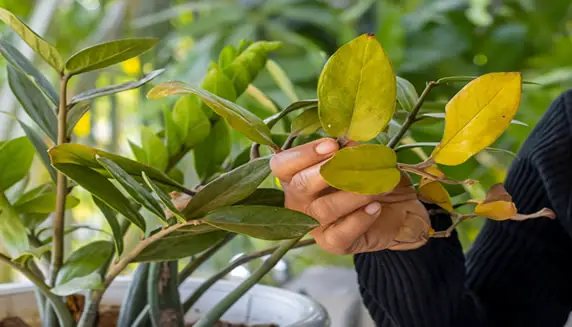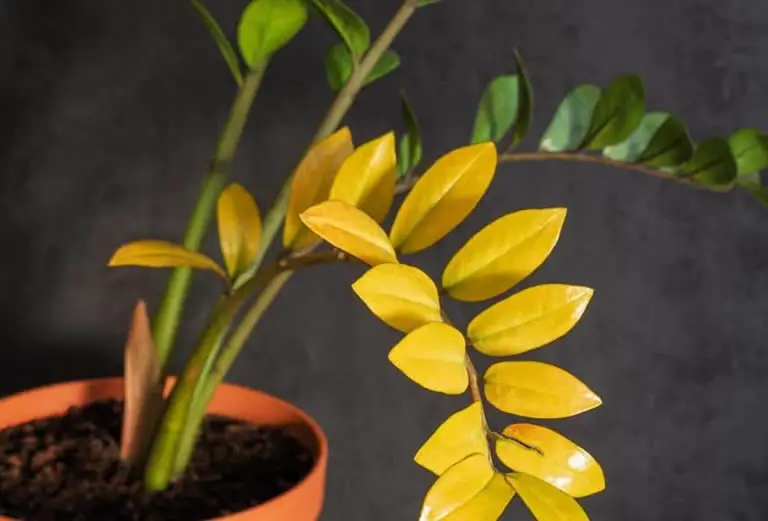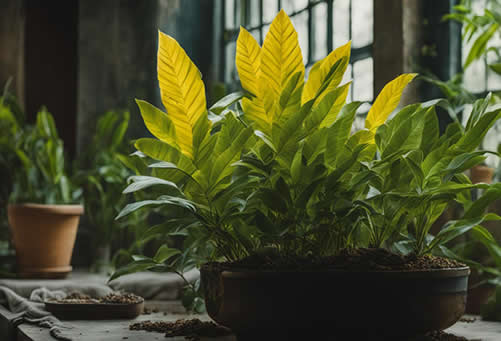If you’re on the hunt for a stylish houseplant that’s easy to care for, the ZZ plant (Zamioculcas zamiifolia) is a great choice. It’s known for its attractive glossy leaves and resilience, but like all plants, it can sometimes show signs of stress. One common issue you might run into is yellowing leaves. But don’t worry—this is usually something that can be fixed, and in this post, I’ll guide you on how to troubleshoot and prevent yellow leaves on your ZZ plant in the future.
Overwatering is the most common culprit, which leads to root rot. But yellow leaves can also point to underwatering, and occasionally, issues with temperature, light, or fertilizing might be to blame.
Although yellowing leaves is not the only ZZ plant problems it is one of the most common (for dealing with other issues see our article 10 common ZZ plant problems & their fixes). If you notice your ZZ plant developing yellow leaves, it’s important to figure out the cause. Understanding what’s making your plant unhappy will help you take the right steps to fix it.
In the sections below, we’ll explore some of the most common reasons for yellowing leaves and give you tips on how to get your ZZ plant back to its healthy self—and keep it that way!
Table of Contents
Top Reasons ZZ Plants Get Yellow Leaves
ZZ plants are known for being tough and easy to care for, making them a go-to choice for those with busy lives or less-than-green thumbs. Their drought-resistant nature is one of the main reasons they’re so hardy.
However, some people mistakenly assume that means they can handle hot sun and high heat, too. In reality, while ZZ plants do well in dry conditions, they’re not as tolerant of extreme temperatures.
If your ZZ plant’s leaves start turning yellow, it can be a bit of a shock, especially since they are so resilient. Yellow leaves are often a sign that your plant is reaching out for help, and it’s a cue that something in its care routine needs attention.
What is one of the most common causes for yellowing leaves on a ZZ plant?
Watering issues!
Luckily, with a few adjustments to your watering habits, you can usually bring your ZZ plant back to its healthy self.
Below, I’ve outlined some common reasons why ZZ plants get yellow leaves and what you can do to fix them.

Overwatering Can Lead to Yellowing Leaves in ZZ Plants
ZZ plants are well-suited for dry conditions, so when overwatered, they can quickly develop issues.
The main problem is root rot, which happens when the roots sit in waterlogged soil for too long. This creates a perfect environment for fungal growth, which leads to root rot.
When the roots are compromised, the plant can’t properly absorb the water and nutrients it needs, causing the leaves to yellow—and in some cases, fall off.
If you suspect overwatering might be causing your ZZ plant’s yellow leaves, here’s what you can do:
-
Check the Soil: First, test the soil. If it feels excessively wet, it’s time to act. Carefully remove the plant from its pot to inspect the roots.
-
Examine the Roots: Healthy roots should be white and firm. If you find brown or mushy roots, those are rotting and need to be trimmed.
-
Prune the Rotten Roots: Use clean, sharp pruners to cut away any rotten or damaged roots. If you find healthy roots, you can make small cuts to promote new growth. Be sure to sanitize your pruners after trimming to avoid spreading the rot.
-
Repot the Plant: Once you’ve pruned the roots, place your ZZ plant back into a pot with proper drainage. Discard the old soil and replace it with fresh, well-draining soil to prevent the problem from coming back.
-
Watering After Repotting: Water the soil lightly, just enough to make it damp. Allow the soil to dry out completely before watering again.
By addressing the root rot quickly and adjusting your watering habits, your ZZ plant has a good chance of bouncing back!


